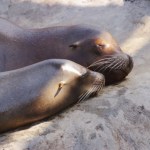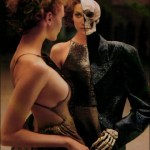skeleton
Image of seals from www.fanpop.com/clubs/the-animal-kingdom/images/14060694/title/seal-wall…
Paleogeneticist Dr. Johannes Krause (University of Tübingen, Germany) and colleagues were interested in the origin of tuberculosis (TB) in the Americas. Since strains of TB found in the Americas are related to strains found in Europe, prior theories held that Spaniards may have introduced it to the Americas while colonizing South America. The problem with those theories is that pre-Columbian skeletal remains showed signs of TB much earlier.
Dr. Krause was quoted in Scientific American, “…
Portland artist Eric Franklin spent over 1,000 hours sweating over hot glass and noble gasses to produce Embodiment, a glass skeleton filled with glowing krypton.
Speaking about the process, Eric says:
Every glass seal has to be perfect, and this piece contains hundreds. Everywhere one tube joins another, or a tube terminates, glass tubes were sealed together. They have to be perfect in order to preserve the luminosity of the krypton. If one rogue molecule gets inside the void of the glass tubing it can eventually contaminate the gas and it will no longer glow. There are times when the…
Portland artist Eric Franklin spent over 1,000 hours sweating over hot glass and noble gasses to produce Embodiment, a glass skeleton filled with glowing krypton.
Speaking about the process, Eric says:
Every glass seal has to be perfect, and this piece contains hundreds. Everywhere one tube joins another, or a tube terminates, glass tubes were sealed together. They have to be perfect in order to preserve the luminosity of the krypton. If one rogue molecule gets inside the void of the glass tubing it can eventually contaminate the gas and it will no longer glow. There are times when the…
A cross posting from my Posterous space - a short imagining some implications of lab-grown meat.
He was a huge man, thick forearms dotted with burns and pale scars. He spoke in a dull monotone about the unique difficulties in preparing synthetic meat. Roscoe wondered how much he weighed, and tried to calculate how much that would be worth when sold in Longpig wrappers. As he spoke, Roscoe noticed the chef was absent-mindedly palpating his own arm, as if feeling for the texture of the meat under his skin.
Read Transubstantiation
Last week I had a visit from a friend of mine, who was on something of a farewell tour. After several years of planning, he'd packed in his dependable but much-begrudged corporate job, and was setting sail for Asia, to see more of the world. He's already seen much more of the world than most people. Not because he was well connected or rich, but because he made it his life's mission to tour the forgotten, the hidden and the forbidden places of the world. I mention this because if there ever was a man to take life advice from, it is this one, and he put into words something I've been…
A restoration of Megatherium from H.N. Hutchinson's Extinct Monsters.
For over a century and a half dinosaurs have been the unofficial symbols and ambassadors of paleontology, but this was not always so. It was fossil mammals, not dinosaurs, which enthralled the public during the turn of the 19th century, and arguably the most famous was the enormous ground sloth Megatherium. It was more than just a natural curiosity. The bones of the "great beast" represented a world which flourished and disappeared in the not-so-distant past, but, as illustrated by Christine Argot in a review of its…
tags: Fledermaus Hologramm, Senckenberg Naturmuseum, museums, Frankfurt am Main, Germany, travel, fossils, paleontology, image of the day, photography
Fledermaus Hologramm.
Senckenberg Naturmuseum, Frankfurt am Main, Germany.
Image: GrrlScientist, 13 April 2010 [larger view]
The skeletons of an adult and a juvenile manatee (Trichechus manatus), on display at the North Carolina Museum of Natural Sciences.
The fail whale comes to rest; the decomposing body of a gray whale is host to a diverse array of scavengers and other deep sea organisms. From Goffredi et al., 2004.
In the deep sea, no carcass goes to waste. Platoons of crabs, fish, and other scavengers make short work of most of the bodies which come to rest on the sea bottom, but every now and then the carrion-eaters are presented with a rotting bonanza; a whale fall. Muscle, viscera, blubber, and bone; it all gets broken down, but it takes so long that the whale carcass actually provides a temporary home for a variety of organisms…
The skeleton of an elk-moose (Cervalces scotti), photographed at the New Jersey State Museum.
The Lady of Broken Hearts
Natalie Shau
Lithuanian artist Natalie Shau works in digital media, mostly using Photoshop. You can see more of Shau's work at her website and at the website of jewelery designer Lydia Courteille, for whom she illustrated a cabinet-of-curiosities themed ad campaign. hat-tip: Haute Macabre.
Richard Avedon, The New Yorker, 1995
Via Haute Macabre, an unbelievable fashion editorial created by Richard Avedon for the New Yorker. I have no words.
Richard Avedon, The New Yorker, 1995
See the complete editorial at Haute Macabre.
Happy Halloween, everyone! In searching for a somewhat frightening image (I already recently used Prestosuchus and Amphicyon), I recalled this photo of the AMNH Tyrannosaurus rex mount. Most of the photos I have of the reconstruction are of the whole head or body, but I especially like this one for far more subtle reasons; the close-up makes it appear as if the dinosaur is just beginning to open its jaws, my imagination filling in the sound of heavy breaths escaping the cavernous tooth-lined maw.
Yesterday my friend Julia commented that one of the best times to visit a museum is in the late afternoon during the winter, and these two photographs will give you some idea why. While the fourth floor of the AMNH is usually bathed in natural lighting during most of the day and artificial lighting from above during the evening, there's a few minutes during the winter months while the sun is getting low in the sky but the overhead illumination hasn't come on yet, a time when shadows sweep across the ancient bones. These two photographs of the "Bear Dog" Amphicyon were taken during that short…
This past week I managed to read Peter Dodson's very helpful book The Horned Dinosaurs from cover-to-cover (in addition to finishing some books on Megalania, dinosaur reproduction, philosophy, etc. A massive book review is forthcoming), one of my most favorite sections being where Dodson walks the reader through reconstructing a Chasmosaurus skeleton bone-by-bone. Oddly enough, I came across the a YouTube video of a self-assembling Chasmosaurus skeleton (embedding was disabled for this video), although unfortunately for curators I have not known skeletons to acquiesce to fully leaving their…


